Menus
Mad MAX ‘Supermot’ Scoot !
Scooters are convenient, motorcycles are fun. One offers utilitarian transportation, the other excitement and thrills. But by combining the two with the introduction exactly 20 years ago, in July 2000, of the world’s first sports scooter maxi-scooter with the 500cc parallel-twin TMAX, Yamaha ended up concocting something that just happened. turned out to be the sum of the two, rather than a simple compromise missing out on each other’s strengths.
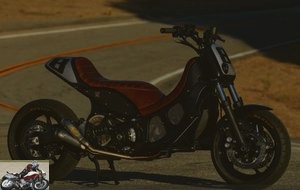 Review of the Yamaha TMAX Hyper Modified
Review of the Yamaha TMAX Hyper Modified
Discovery
The 300,000 customers in Europe alone (including more than 190,000 in Italy alone!) For the seven different versions of the TMAX (updated every four years since its debut, the last of which this year with the 560cc model) all say that Yamaha has achieved its goal with this. A result that lives up to its record as the most consistent of the four Japanese manufacturers in terms of innovation. After having taken up the challenge of catching up with its rivals in the larger and heavier twin-cylinder models such as the Suzuki Burgman and the Honda Silver Wing, or more easily the large mono European and Taiwanese, Yamaha has reached and still retains 60% of the market share of the maxi-scooter segment over 300 cm3, a situation that persists despite BMW’s foray with its C650 Sport and GT since 2012.
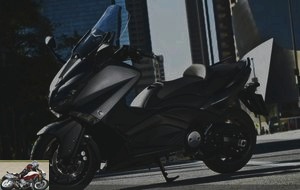 The original Yamaha TMAX 530
The original Yamaha TMAX 530
But, how do you make a scooter as sexy as it is practical? Fun and functional? Answer: send it to Sands and ask him to work on it! Roland Sands Design (RSD) is the famous Los Angeles-based preparer who has developed models that are generally both beautiful and efficient..
And that’s exactly what Yamaha Europe’s product manager, Shun Miyazawa, did in 2012 with one of the 530cc maxi-scooters of the last generation of the time, in the same way as for the VMAX a year ago.
The result was RSD’s TMAX Hyper Modified (a name that sounds like a no-brainer). After making its debut at the EICMA show in November 2012, the hyper-modified maxi-scooter embarked on a world tour before returning to Roland’s workshop to finally be piloted..
 Just before the TMAX, Roland Sands had already hyper-modified the VMAX
Just before the TMAX, Roland Sands had already hyper-modified the VMAX
Roland sands :
I have to say this scooter has been one of the toughest projects I have done to date. I always wanted to turn it into a motorcycle! My design instinct told me to eliminate the apron, straighten the line, and build a custom tank to make it a cafe racer. But I was like, whoa, if we’re gonna make a motorcycle, let’s start with a motorcycle. Let’s take advantage of what this thing is: a scooter! There’s a reason the engine is so low, why it’s under the saddle, why the tank is placed that way … so we ended up building some sort of "surf racer" that we sit on, that you can take to go to the beach but also to have fun in the winding roads of the canyons. Call it a ‘Supermot’ Scoot !
 Originally, RSD set out to turn the scooter into a cafe racer
Originally, RSD set out to turn the scooter into a cafe racer
However, if he decided to do something completely different, Sands initially struggled to figure out what exactly:
There was nothing easy about this project, it was like walking on Mars. There were no guidelines, no magazines, no pages of content on the Internet to guide critical design decisions. Basically no one had ever done something like this before. There was no one to call on the phone who would have had something similar. There was really nothing but our own ideas and inspiration. This means that this is one of those projects where everyone is fighting to put their own mark on it. So there is a surfboard rack on it, a drink holder on the front, we even hung a cooler on the back. In fact, we have a lot of accessories already designed for when Yamaha would put it into production. As if it was gonna happen !
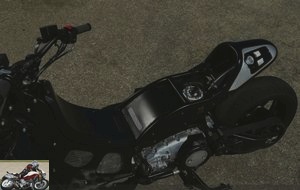 All the superfluous has been removed from the TMAX, ensuring significant weight loss
All the superfluous has been removed from the TMAX, ensuring significant weight loss
Eventually, the decision was made to bring the TMAX back to basics by removing the bodywork to create a stripped-down Superscoot ‘visually focusing on the chassis below, which is normally hidden away..
I saw the photo of a bare TMAX and was blown away by what was under the plastic, with the frame. Structurally, the TMAX looks really cool. He’s quite different from everything else, a little weird even and I like that. But we had budgetary constraints from Yamaha. So we stayed with the original chassis like wheels, brakes, suspension and so on. It’s one of the few machines I’ve built that keeps all of that, although I would have loved to put small wheels on it. So preparation was more about throwing things in than bolting parts. But we have removed so much weight, at least 36 kg, that even if the engine remains stock it sends even harder than the original model. !
A large part of the scooter has therefore remained original, starting with the 530 cc parallel twin engine with 180 ° setting which, despite a new pair of freer megaphone silencers, does not really improve the 46 horsepower claimed by Yamaha. at 6,750 rpm. The torque is established at 52 Nm.
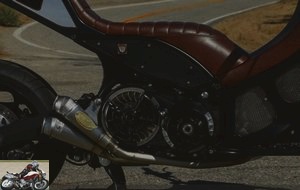 The 530 cc engine was not changed, only the double silencer was changed
The 530 cc engine was not changed, only the double silencer was changed
The aluminum tank, which is now filled at the seat backrest, was completely redone by RSD with a capacity of 11.35 liters, then repositioned under the aluminum rear section of the saddle. The seat is now covered in brown leather with beige stitching made by Bitchin Seat Co. in Menafee while the paint on the scooter is the work of Olympic Powdercoating in Santa Ana. At the front, the aluminum number plate made by hand supports the only headlight of the scooter and benefits from the same paint..
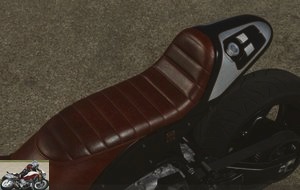 Stitched leather saddle marks the style of the Hyper Modified
Stitched leather saddle marks the style of the Hyper Modified
The radiator was flipped to the side with new brackets and a fairing built to channel air into it. The swing arm appears to have been lengthened, but it has not. It is well stocked, as are the wheels which look like new equipment but are not. These are fitted with Dunlop Sportmax GPR-100 tires in 120/70-R15 at the front and 160/60-R15 at the rear. The TMAX also retains its 43 mm fork with 120 mm travel and set to a 28 ° opening as well as its KYB rear shock working on 116 mm. Same goes for braking with the two front 267mm discs and twin piston calipers with the 282mm rear disc and single piston caliper.
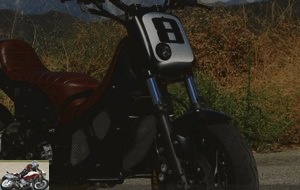 All the chassis remains original, like the 43 mm fork
All the chassis remains original, like the 43 mm fork
Test
Roland had warned that the engine was sending strong. And this is the case as I was able to discover it through the San Gabriel Mountains north of Los Angeles, with the twin offering deep-sounding music that echoes on the rock walls of the canyons thanks to the RSD exhaust. If the engine does not gain power, the performance gain is really noticeable thanks to the total weight reduced by almost a third with all the bodywork removed.
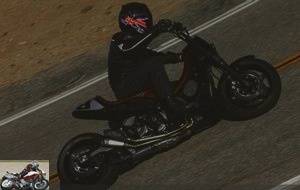 If the engine remains at 46 hp, the performance gain is felt through weight loss.
If the engine remains at 46 hp, the performance gain is felt through weight loss.
The result is a maxi-scooter transformed into an improbable dragster that sticks your banana at every stop at a red light while you are only waiting to turn your wrist to unleash further acceleration. It’s even more impressive out of bends where the maxi-scoot is literally awesome. It’s a word overused but it describes exactly the effect this Naked Superscoot has on when you open the throttle wide. And all this without having to work on a clutch lever or a gear change! Just turn and go! I can not tell you at what speed or speed this happens for the simple reason that Roland has removed the instrumentation (too bulky), but oh so informative, in his work of lightening. And he hadn’t replaced it with something more discreet at the time of my test. But acceleration seems to be available virtually anywhere in the rev range, giving it a good kick in the ass via the Kevlar belt-driven CVT transmission. You can also hear the latter when you release the throttle to enter a curve in a way that was not as loud on the Tmax Stock and which adds an additional touch of personality to this "bike" already unlike others.
And yes, it is a motorcycle, especially in the way it turns and handles, with good ride quality and excellent damping thanks to the stock KYB suspensions which have not been recalibrated to account for the new weight. 130 kg, with the fuel tank full.
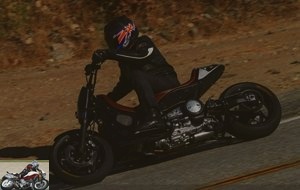 In this configuration, the TMAX is almost akin to a motorcycle in terms of its sportiness.
In this configuration, the TMAX is almost akin to a motorcycle in terms of its sportiness.
You can’t help but enjoy the performance of the Tmax as well as its efficiency. Finding yourself in traffic on a winding road and getting rid of other drivers by simply opening to propel the Yam ‘with a bound to the next bend quickly becomes addicting. Mid-range acceleration is particularly rapid when the Hyper Modified is operational. There is still sometimes a turbo-like lag when turning the grip, possibly due to the CVT transmission taking its time to deliver the extra power you just asked for from the handlebars. The best way to counter this is to hold the rear brake while accelerating in the turn, which effectively preloads the throttle and thus eliminates "turbo lag". A technique that is particularly useful on a winding mountain road where you want to maximize acceleration in series of slow turns..
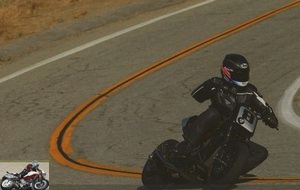 The TMAX is sharper than ever, despite some delays in acceleration out of a corner
The TMAX is sharper than ever, despite some delays in acceleration out of a corner
The small size of the TMax makes it possible to switch from one angle to another with disconcerting ease in the sequences of virolos, in particular on this stripped-down RSD Hyper while the TMax remains the lightest and most manoeuvrable of the multi-cylinder maxi-scooters thanks to its perimeter frame in cast aluminum which sets itself as a benchmark. This also goes for the smoothness of its handling, a key factor making this Yamaha more of a motorcycle than a scooter. It proved, to my great satisfaction, in the way I could take it around the corner despite the myriad of curves of Glendora Mountain Road, alternating tight and fast curves with the KYB suspension devouring the bumps without deviating. Mr. MAX of the trajectory I had chosen to make him follow. This 160/60 R15 rear tire provides fabulous corner grip when turning the grip hard enough and the 120/70 R15 rounded front end gives a lot of confidence to maintain passing speed. Hang the rear Dunlop on the ground at the exit of a curve by opening the accelerator while leaning towards something which approaches the maximum angle of 50 ° the machine allows to know the type of acceleration that many motorcycles of 500 cm3 would envy.
 The original cycle part is excellent on winding roads
The original cycle part is excellent on winding roads
Part of that comes from the die-cast aluminum swingarm that works with the KYB damper in traction rather than compression and offers 116mm wheel travel, matching the 43mm motorcycle-style fork up front. and its 120 mm travel. Honestly, I don’t think there is another combustion engine vehicle that could have gotten me up and down the switchbacks of the canyon more than the Sands Superscoot because you’re always on the right gear at the right time. with the right rpm for each hairpin bend, for the simple reason that there is only one gear. So just turn the handle and goooo !
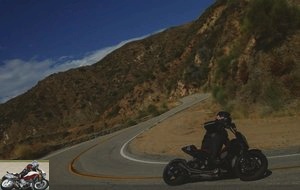 More than ever, the TMAX incites unreason
More than ever, the TMAX incites unreason
A slight point of irritation is on the switch which has been transferred to the side of the scooter behind the left leg and which is far too easy to touch when moving on either side of the saddle, because you inevitably end up by manhandle this Hyper Modified through hairpin bends at unlikely bank angles that Dunlop Sportmax GPR-100 tires and stock 15-inch rims can achieve. It took this four times before I finally remembered that after pressing the switch again, but before pressing the starter to restart the engine, I had to grab the rear brake mounted on the handlebars on the left. to override the power cut and turn it back on !
Cycle part
At first it felt weird to ride what behaved like a cafe racer but with nothing between the knees to grab hold of and a rear brake that I had to work on with my left hand rather than my right foot. Once I accepted this minimal space to accommodate my size 44 boots, it became really easy and so addicting how fast I could take it around the corners..
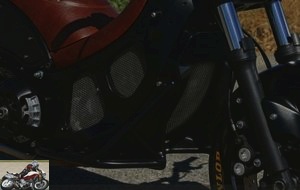 The running boards of the Yamaha TMAX Hyper Modified
The running boards of the Yamaha TMAX Hyper Modified
The steering is pretty sharp for these small wheels, especially with that 120/70 motorcycle-like front tire, despite the fork opening at 28 °. It is quite possible to use the good grip of the Dunlops to exploit this maximum angle of 50 °, although the center stand may rub on the left and the lower silencer on the right. But thanks to its good balance, the TMax remains stable in the fastest corners, even those with a bump in the middle thanks to the quality of the suspensions and the low center of gravity which helps smooth out any shock. The only time I was able to get it to move was on a corner taken at 80/100 km / h at mid-speed on a bumpy surface, when the scoot started to sway slightly before the long wheelbase, the center. low gravity and conservative geometry ensure a return to normal. But under normal use, the TMax remains incredibly stable.
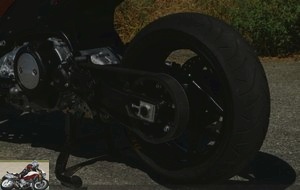 Dunlop Sportmax GPR-100 tires provide excellent grip
Dunlop Sportmax GPR-100 tires provide excellent grip
The Renthal FatBar handlebars mounted on 2 1/2 inch saddles give excellent sporting posture, encouraging you to throw the TMax out of the corner to take a turn and trust the grip of these Dunlop Sportmax tires to keep you going. to go through curves at improbable speeds.
Braking
The very low weight allows the original brakes to perform even better than before. You just have to remember that the rear brake is activated on the handlebars and not where you could look for it with your foot when you are used to the bike. Another reason is the exceptional performance of the brakes themselves. After losing a third of its dry weight, the stripped-down Supercoot is even over-equipped-over-braked with its dual 267mm floating front discs and sporty four-piston Sumitono monoblock calipers, backed up by a rear brake. oversized 282mm worthy of an American flat tracker. By motorcycle standards, the Yamaha stops quite well, but for a scooter the quality of its brake system is extremely good..
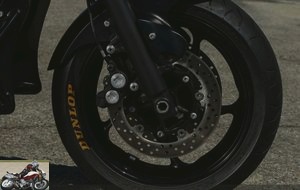 With a third of the weight less, the brakes are even more efficient
With a third of the weight less, the brakes are even more efficient
Conclusion
Absolutely no one has ever driven the Hyper Modified without leaving with a big smile! It’s cute, it’s practical, it’s quick because we’ve removed a lot of weight, but it’s also accessible. Just turn the handle and go: no clutch. Even a child could drive it! And anyone who wants to push it all the way can do it too. I fly it a lot myself and people panic when they see it. To be honest, I didn’t expect to like it that much, but it’s so different and weird, while working great. It still rides the same as an original TMAX, but it’s even lighter and more agile. In addition, it now sounds like a dirt bike with its racing exhaust … as Roland recalls.
 Yamaha TMAX Hyper Modified by Roland Sands Design
Yamaha TMAX Hyper Modified by Roland Sands Design
This is very true and the proof is that I want one for myself! Riding the Yamaha TMax reduced to its bare minimum by Roland Sands was REALLY fun! By putting this stripped Superscoot ‘on the diet, the Californian trainer has created a mixture of practicality and additional performance and therefore seduction. This is the kind of machine that you can take to go for a walk in the city or simply to have fun..
Strong points
- Engine liveliness
- Lightness of the cycle part
- Ease of handling
- Braking
Weak points
- Do not incite reason
- No counter
- Some delays in acceleration
The technical sheet of the Yamaha TMAX Hyper Modified
Related articles
-
Yamaha TMax 560 TechMax maxi-scooter test
Standard vs TechMax: which model to choose ? Twin cylinder of 562 cm3, 47.6 hp and 55.7 Nm, 218 kg, from 11,990 euros 7th generation! Yes the Yamaha TMax…
-
2015 vintage Thirteen years since the TMax made its appearance with several major evolutions since the TMax 500 cm3. If the maxi scooter evolves again in…
-
Yamaha Xmax 300 Iron Max scooter test
Unlimited version of the tuning fork maxiscoot Leather, seat with backrest, aluminum footrest, specific color… A scooter is always worth less than the…
-
The two top-of-the-range versions of the Tmax are rich in electronics and comfort and safety equipment In-line twin, 46 hp, 53 Nm, traction control,…
-
Yamaha RZV 500R motorcycle test
GP 500 2 stroke … road ! 50 ° V4, 494 cc, 100 hp, 134 kg Sports bikers are familiar with the Yamaha RD 500 LC, inspired by Kenny Roberts’ YZR500….
-
Yamaha TMax 530 ABS scooter test
The Thug Star The TMax is the big Yamaha scoot, even THE big benchmark maxi-scooter, to such an extent that it is the main target of copies of the…
-
Yamaha VMAX Cafe Racer motorcycle test
Rocket hyper modified by Roland Sands Design The Power Cruiser stripped down to lose 36 kg The Yamaha VMax is undoubtedly one of the most iconic…
-
Access to the Dark Side of Japan for adults from 5199 € 42 horsepower at 10,750 rpm, 29.6 Nm of torque at 9,000 rpm, for A2 licenses At Yamaha, the MT…
-
Piaggio MP3 300 HPE three-wheel scooter test
True False Yourban 180,000 MP3s sold worldwide! Almost all of which is sold in France! This is how to sum up the three-wheeled scooter. A success that…
-
Italjet Dragster 125 scooter test
Urban SuperScoot Single cylinder 4 T, 125 cm3, 14.9 hp, 12.5 Nm, 108 kg dry, 5,000 euros Italjet and its extraordinary scooter: the Dragster! Almost tent…
A quick look back at the Roadsmart 2.
The front is dead from home dead at 6800 km: smooth on the left side, half-witnesses to the right and to the witnesses in the center.
The rear could have done 500 km more. Unlike the front, wear is very even over the entire tread.
So I will have done about 400km less than the R 1s, yet overall I rode less in periods of (very) hot heat and especially less attacking. Note that they literally collapsed in the last 1000km.
As for behavior, it’s all good: heating time, precision, stability on the angle and resistance in the rain (what rain ???) at the top. They are also a zest more sporty than the 1.
In short, I get along (and my bike too) well with them and I go up the same.
Only downside, given the price increase compared to the Roadsmart 1, the lower endurance of the R 2 hurts the c * l …
Yop,
I confirm 8000km on my er6f.
The central tread made the soul.
I put the same tire back on because the felling is good.
Next time it will be a PR3 train
A quick look back at the Roadsmart 2 (CONTINUED):
this time the front is still dead (very dead) and very early at 4500km. The rear still has 2000 / 2500km of life expectancy.
It’s curious and annoying because the Roadsmart 1s wore out together and allowed the entire train to be changed. So, although very happy with this rise in terms of quality / safety, I think I’ll turn to something else, maybe the Pirelli Angel GT well rated by Moto Mag.
It will serve as a test for the owners of fat grannies like mine.
Very complete article … I hesitate now …
It is not said enough that the version "O"mainly concerns motorcycles "big and heavy".
I put an "M" on the front, keeping a "Roadsmart II"at the back. Z8, by habit.
Too much salt on the road for the moment … To see, therefore.